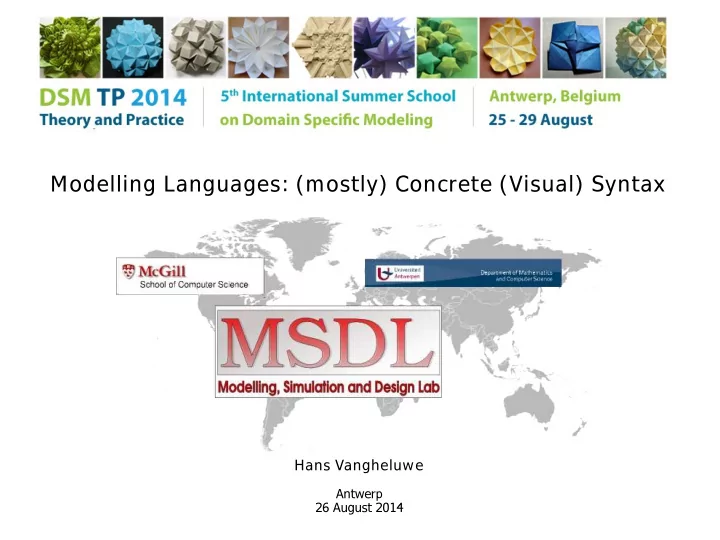

Modelling Languages: (mostly) Concrete (Visual) Syntax Hans Vangheluwe Antwerp 26 August 2014
2
3
4
5
6
Causal Block Diagrams (syntax) 7
Causal Block Diagrams (semantics) 8
Operational Semantics 9
Causal Block Diagrams (semantics) 10
Formalism Transformation Graph (FTG) 11
Modelling Languages/Formalisms Syntax and Semantics 12
Modelling Languages/Formalisms Syntax and Semantics Explicit Modelling of Modelling Languages/Formalisms 13
Semantics of Meta-models What is the semantic domain of the Class Diagram formalism (when used as a meta-modelling language)? 14
Textual Languages Modelling Languages/Formalisms 15
Textual Languages Textual Languages “this sentence is very short” ● Individual letters in an alphabet ● Combined into words ● Combined in to sentences in a language ● Letters in words specifjed by regular expressions ● Words in a language specifjed by a grammar ● Symbols are combined by “is to the right of” 16
Textual Languages 17
Visual Languages 18
Visual Languages Plex 20
Visual Languages Graph 21
Visual Languages Connection Types 22
Visual Languages Iconic 23
Visual Languages Box 24
Visual Languages Visual Language Classes 25
Visual Languages Hybrid Languages 26
Visual Languages Syntax-directed Visual Editors: model behaviour 27
Visual Languages Syntax-directed Visual Editors: model behaviour 28
Visual Languages Syntax-directed Visual Editors: model behaviour 29
Visual Languages Syntax-directed Visual Editors: freehand (early stages of multi-domain project) 30
Visual Languages Different Media: Gestural Interaction, Sound, ... 31
``Physics'' of Notations Introduction ● Visual notations pre-date textual ones ● Visual notations are important for Modelling and Software Engineering ● Humans are excellent pattern recognizers ● Need cognitively effjcient and effective notations. Cognitive effectiveness = speed, ease and accuracy with which a representation can be processed by the human mind a DSVL @ Lascaux 33
``Physics'' of Notations Introduction/Rationale Visual notations are often introduced without underlying theory or rationale Many visual notations for same concepts. No rigorous way to compare effectiveness and hence no clear design goal. 34
``Physics'' of Notations Communication Theory 40
``Physics'' of Notations Encoding: 8 visual variables to (graphically) encode information 41
``Physics'' of Notations Decoding automatic, fast, parallel slow, large effort, sequential Appropriate notations » offmoad some of the burden from cognitive to perceptual Note: “dual channel theory”: brain processes textual/audio in parallel with visual data 42
``Physics'' of Notations Principles for Designing Effjcient and Effective Visual Notations 43
``Physics'' of Notations Semiotic Clarity (semiotics = study of signs and sign processes) 1 to 1 44
``Physics'' of Notations Perceptual Discriminability 45
``Physics'' of Notations Perceptual Discriminability should be easy to distinguish visual symbols ability to distinguish is determined by visual distance larger visual distance » faster, more accurate recognition ● number of visual variables on which they differ and the size of the differences ● shape is the main visual variable 13 46
``Physics'' of Notations Perceptual Discriminability Software Enginering notations mostly use rectangle variants Use redundant visual encoding to increase distance (e.g., textual + visual) 47
``Physics'' of Notations Semantic Transparency The meaning of a symbol can be inferred from its appearance (intuitive) Symbols can be: • Semantically Immediate • Semantically Opaque • Semantically Perverse Software Engineering notations are usually abstract (non-intuitive) Domain-specifjc icons are intuitive 48
``Physics'' of Notations Semantic Transparency 49
``Physics'' of Notations Complexity management (# elements in diagram » cognitive overload) 50
``Physics'' of Notations Modularization/Hierarchy 51
``Physics'' of Notations Cognitive Integration (different notations) ● Conceptual integration (coherent mental model) ● Enable navigation and transition between notations 52
``Physics'' of Notations Visual Expressiveness Number of visual variables used (UML, mostly shape, no colour) 8 degrees of visual freedom (0 = non-visual – 8 = visually saturated) 53
``Physics'' of Notations Visual Expressiveness Different visual variables have different capacity to encode information 54
``Physics'' of Notations Dual Encoding Combine Textual and Visual Supplement rather than duplicate (e.g., cardinality values) Reinforce meaning 55
``Physics'' of Notations Graphic Economy ● Not too many symbols. If many, provide legend ● Limit on human discrimination capability (6 levels per variable) ● Upper limit on graphic complexity How? 56
``Physics'' of Notations Cognitive Fit Adapt choice of visual notation to ● Task ● Audience novices and experts Adaptation may be dynamic (“learn” about Task/User profjciency) Representation medium 57
``Physics'' of Notations Interactions among principles 58
Recommend
More recommend